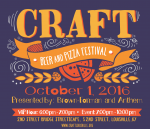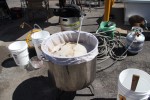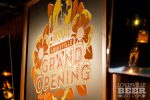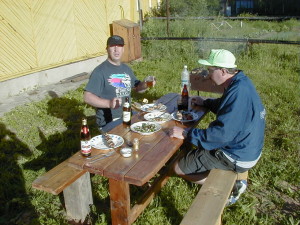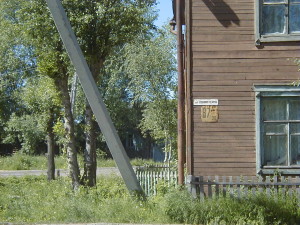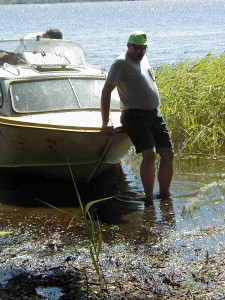A travelogue in three parts.
March 31: (1) A tale of a fateful trip.
April 7: (2) The future is the past.
April 14: (3) Beer hunters lurking nearby.
(3) Beer hunters lurking nearby.
I awoke groggy and disoriented. We had retreated indoors quite early the previous evening, aiming to avoid mosquitoes of Biblical proportions, and sat inside talking and drinking Baltika Porter in the odd glow of a never quite black summer’s night.
Allan’s local helper had been commissioned to prepare fish soup for a midday meal to be consumed just prior to making the drive back to Moscow, and this left us with several hours to explore. Allan proposed a drive to a nearby town.
Armed with bootlegged Jackson Browne and Bad Company CD’s procured for next to nothing at the thriving music market back in Moscow, we set out for the scenic trek to Kolyazin, a dusty and isolated nowhere town that has the eternal good fortune to be dusty and isolated less than four hours away from Moscow – this being “good fortune” because a brief look at any reputable map of Russia will reveal there to be hundreds of Kolyazins, most of them located in places that are so lost in the middle of nothingness that they might as well be on another planet.
The open road led through another unreconstructed Soviet-era plantation, then into the “city” limits. A right turn, a rutted dirt street sloping downhill, cracked and peeling pre-revolutionary houses … and at the bottom of the incline the street abruptly stopped at water’s edge. Ahead of us, one hundred yards from dry land, completely surrounded by water, was the steeple of an Orthodox church, which had been converted into an island by damming the river some years before, no doubt pleasing the five-year plan of numerous atheistic bureaucrats.
As it had since the revolution, Kolyazin’s bleak main square was being overseen by V. I. Lenin, his statue no more weed-encrusted and neglected than the remainder of town. The market showed a few more signs of life. Accompanied by children who had sold their services as “protection” for a few cents – they were supposed to be guarding the car, but kept wandering off to invest their newfound wealth in ice cream cones — we bought a few more bottles of beer and surveyed the dismal trinkets.
Meanwhile, Allan had determined that beer was available in one or all of three places: The market itself; a nightclub; and on draft in a genuine tavern, which was rare in the countryside. The market had bottles of Baltika (rapidly becoming a good sign), and the nightclub was closed; also good, judging from the decrepit appearance. The tavern was located in a relatively new addition to an older building and appeared positively upscale compared to the surroundings, but once inside, the ambience was late Spartan: A few wooden tables, plastic chairs, and a window to order and collect the beers.
A young, engaging woman served us from behind the counter, noting to the ever-solicitous Allan that the beer was brewed locally and giving him vague directions to the site. As he relayed this information, I saw Barrie’s eyes following something at the base of the wall. It was an adapted garden hose, now serving as the line carrying the beer from the cellar to the tap. Nonetheless, it wasn’t bad golden lager, a bit yeasty and perhaps on the unfinished side, but refreshing. We now resolved to find the brewery.
Back on the main highway on the outskirts of Kolyazin, we followed the barmaid’s ambiguous directions. Eventually Allan pulled over to the shoulder to ask a pair of slack-jawed pedestrians if they knew the location of the brewery, and in opportunistic fashion, they offered us this critical information in exchange for a small fee: A ride.
Moments later the car came to rest in front of what appeared to be a collective farm storage building, more gray concrete with rusty port wine stains down the sides, and no discernable activity on the premises. Our sweaty passengers swore to the authenticity of the site, and suggested that we ask for the proprietor in a cluster of houses at the end of a muddy lane that was sufficiently booby-trapped with potholes that Allan correctly feared for the life of the car. It was midday, and there were few signs of people to ask directions, so we elected to abandon the brewery chase.
Allan drove back down the dirt road to the highway, and as we pulled out I happened to see a hand-lettered, cardboard sign with an arrow pointing to the left and a single word in Russian, one announcing the site of the Grail: Пиво … PEE-voh.
Or, “beer” in the Russian tongue.
It was the quintessential roadside beer stand, the mysterious local brewery’s de facto open-air tap room, nestled under the welcomed shade of trees in a farmyard littered with puddles, chicken droppings and fish bones, where a lady poured beer from a rigged faucet attached to a single keg, minus the needless expense of extras like refrigeration or television advertising.
At her disposal were six mugs, a basin of well water for rinsing them, and a bowl of rubles for making change. A half-liter of draft beer cost 25 cents, and the origin of the bones was revealed when I offered her a 20-ruble banknote for two beers, and in lieu of coins, she offered two small, leathery smoked fish in return.
Barrie and I chewed on the pungent freshwater fish jerky as Allan conversed with the proprietor, learning that the building we had found indeed was the brewery, that is was operated by a Moscow man who’d moved to the countryside, and that the business was growing.
The beer itself was the same fresh, golden, unfiltered lager that we’d sampled back in the Kolyazin pub. How good was it? I feel that it would be wise to subordinate any critique to the uniqueness of the setting, seated on a wooden bench, washing away the dust and midday heat with a cool (not cold) beer, and watching two hilariously drunk local farm workers in action.
Their extended liquid lunch break apparently having come to an end, along with the bulk of their money, the two staggered to their feet. One of them pressed coins into the hand of an old man seated nearby, who nodded and disappeared around the corner. Within minutes the old man reappeared, bearing a washtub filled with water, which he proceeded to dump over the heads of the delighted drunks. Soon their ancient Lada sputtered out onto the highway, and when we also left soon after, we were careful to drive the opposite direction.
Postscript: Mother Russia & Sand Island.
The boat drifted toward shore, the engine was cut, and we were as close as we were going to get to Sand Island. If I intended to make the picnic and enjoy my salami and Budvar, I’d have to get my feet wet. To the surprise of none, Barrie had no doubts: “I’m going in,” he announced, and commenced swaggering through the knee-deep water.
As so often before, I was quite happy to let him do the blocking, and after my initial hesitation, I found the layers of black mud and decomposing leaves to be reassuringly soft between my toes.
Clambering up the wooded hillside, we established camp in a sandy clearing and watched through the gently swaying branches as the boat disappeared over the horizon.
It was as peaceful an idyll as I’ve ever known. The salami was greasy, the Budvar beer outstanding, the company of my good friends valued, and the mud – the timeless Volga mud clinging to my feet – unexpectedly reassuring.


